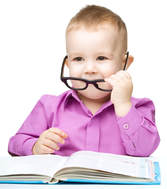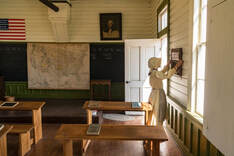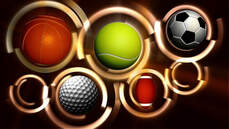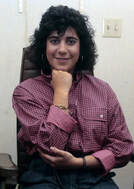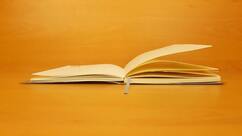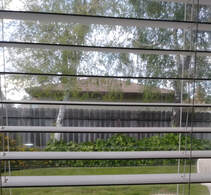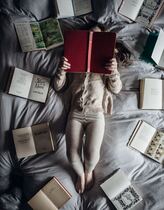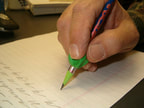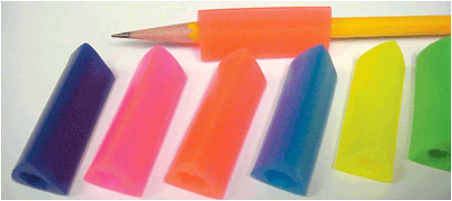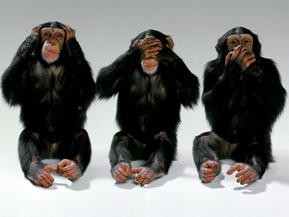Lens Therapy Explained
|
Lens therapy is prescribing for where you want your eyes to be rather than where they are now. Lens Therapy prevents your eyes from getting any worse and may improve your eyes so you won't have to wear compensative glasses (often misleadingly called corrective glasses). Lens Therapy glasses are the only truly corrective glasses. Yes, you are wearing preventive glasses for limited periods to prevent you from having to wear compensative glasses full time later!
|
Lens therapy treats eyestrain while providing comfort and efficiency when wearing these specially prescribed glasses for near vision tasks. For those who already have a prescription, Lens Therapy is also available in a bifocal form.
Research indicates eye strain causes nearsightedness, astigmatism, farsightedness, and other vision problems. Thus, with Lens Therapy we may prevent or even reverse these conditions as the eyestrain is eliminated.
Research indicates eye strain causes nearsightedness, astigmatism, farsightedness, and other vision problems. Thus, with Lens Therapy we may prevent or even reverse these conditions as the eyestrain is eliminated.
Vision hygiene to accompany Lens Therapy: Seven Steps to improve your vision.
STEP 1 GOALS
|
BELIEF & GOALS - lens therapy
Belief will aid you in almost anything you do. Already we know that people who believe they can get well heal faster than those who don't believe they can heal. Therefore it will be helpful to believe you have the drive and will - power to follow through with lens therapy. Believe the lenses will improve your vision system. |
Reading uplifting books may be an additional help. There is a plethora of such books readily available. Once you have belief, goals are helpful so you know what you want to accomplish with your vision and how well you've succeeded once finished. Following is a list of goals, all of which can be achieved by improving your vision system. Check the goals you desire and don't hesitate to add others of your own. Constant referral to your goals during care is beneficial.
|
Sports:
1. keep eye on the ball 2. improve any sport 3. run straight as look to side 4. concentrate better 5. increase attention span 6. more consistent 7. expand side vision Reading:
1. read faster & longer 2. improve comprehension 3. spell better 4. visualize silent or oral material 5. hold book at normal distance 6. keep place 7. no sleepiness or tiring eyes 8. don't burn or itch reading 9. don't avoid reading 10. no head turn 11. don't use finger 12. eliminate sub-vocalizing 13. don't skip words 14. no reversals 15. don't reread same line 16. don't repeat letters in a word 17. don't mistake words with similar beginning or ending 18. remember the same word in the next sentence 19. don't omit small words |
|
STEP 2 CONTROL OF YOUR ENVIRONMENT
Today only two theories exist to explain eye defects - heredity and the influence of your environment. We cannot do anything about your heredity, but we can show you ways to modify your environment. Many suggestions to control your environment are included here for your lens therapy care. Learn them at your pace. Remember you probably can't make these changes all at once. Simply keep adding one thing at a time. |
|
PROPER READING DISTANCE - NO HEAD MOVEMENT
During your first month of lens therapy you have two goals concerning general environment. 1. Goal one during the first two weeks is to establish a habit of holding reading materials at the correct distance. That is 15 - 16 inches for adults and usually no closer than 13 inches for children. The exact distance for each individual is between the elbow and knuckles. Make a fist, hold it to your chin, and note the distance to the end of your elbow. That is your closest reading distance. |

2. Goal two for the second two weeks is to eliminate head movement while reading. Both habits are hard to establish by yourself so ask others to observe you. Large amounts of close work leads to eyestrain, which causes you to get close to your book. That results in head movement that shuts down vision information processing and opens up auditory processing. This causes verbalization, either silent or out loud and slows reading and reduces comprehension. That leads to more strain and the cycle begins. Your lens therapy glasses both relax your eyes to avoid strain and make things appear farther away to help establish the correct reading distance.
|
SUGGESTIONS FOR VISUAL HYGIENE
1. When reading: a. Be aware of space between you and the page and things around and beyond the book. b. Occasionally look off at a specific distant object and let its details come into focus. Maintain awareness of other objects and details surrounding it. Do this at least at the end of every other page for children - every 15 minutes for adults. |
|
Adults should look up after 15 minutes and concentrate on an object, not just stare. It is preferable to look beyond 20 feet, ideally out a window and if possible view and appreciate greenery. Greenery relaxes your eyes, and that is what we are trying to accomplish. Get up and move move every 30 minutes. |
|
d. Sit upright and practice holding your back arched while reading or writing. Avoid lying on your stomach on the floor. |
|
|
2. Do not sit any closer to the TV than 6 to 8 feet, be sure to sit upright, and keep good posture. Watch TV in normal room illumination. Do not turn the room lights off. |
|
|
|
3. When riding in the car avoid reading and other near point activity. Encourage looking at sights in the distance for interest and identification.
|
|
6. Walk with head up, eyes wide open and look towards not at objects.
|
|

2. Keep feet parallel.
2. Keep feet parallel.
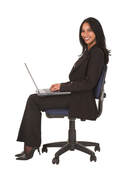
3. Sit up straight in a chair with the back of your hips against the chair.

4. Often think of what you will do tomorrow or in the future.

5.Before you start something make sure you have a plan
6. Once you have a pan , then determine the general idea upon which it is based
6. Once you have a pan , then determine the general idea upon which it is based
|
7. Stand straight with your head back (ears even with shoulder not in front of them) chin tucked, stomach in, and hips back.
|
|
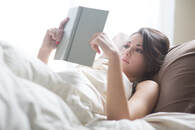
8. Avoid reading in bed or the reading ion bed posture.

9.Always, no matter how brief a time use your lens therapy glasses when reading or using a digital device.
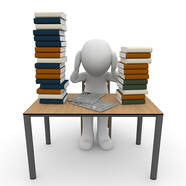
10. Discourage "bookworm" habits and substitute other creative activities.

11. Remove distance (minus) eyeglasses for meals and other close work.

STEP 3 DESK WORK
Feet are to be flat on the floor. A good desk height lets you swing your arms in a bent position so the elbows skim the desk top. Kitchen or dining room tables are usually too tall for children.
Feet are to be flat on the floor. A good desk height lets you swing your arms in a bent position so the elbows skim the desk top. Kitchen or dining room tables are usually too tall for children.
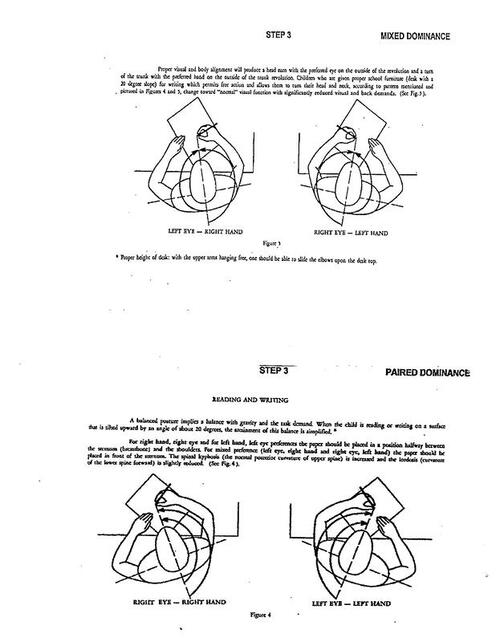
A slanted surface of 20 degrees is ideal for writing, drawing, and reading. Placing a loose leaf binder on a flat desk with the thicker end away will be sufficient, even though not quite 20 degrees.
The picture to the left shows proper posture at a desk for cross and same dominance. We are working on getting better pictures, but this should help
The picture to the left shows proper posture at a desk for cross and same dominance. We are working on getting better pictures, but this should help
The chair should be free of the desk, turned to the side. For a right handed person, it should be turned 20 degrees to the left so the left wrist is at the edge of the desk. The paper should be slanted appropriately and held with the left hand at the lower left hand side. ( see below ) This posture with the left elbow below the desk surface, allows the shoulders to be level when writing. While reading the chair should be straight at the desk.
Ideally the desk should be a bright almost white pine color with darker swirls. Contact paper of this color can improve the darker colored desks. Concentrated lighting to one side to avoid glare should be used. Also general room illumination should be used to avoid too great a contrast.
Place the desk so that with a turn of the head one can look beyond 20 feet such as a window, but not directly in front. If impossible a mirror can be set to provide as much distance as possible.

This grip although a three finger pincer grip is inefficient. The pencil is gripped so tightly that the first finger's knuckle is bent backward and the hand is beginning to form more of a fist. The gripper of soft rubber will remind you to gently grip the pencil. The fingers are beginning to get too close to the tip of the pencil making you get closer to the paper to view the point. That adds more eyestrain.

STEP 5 PHYSICAL EXERCISE
By doing any exercise, even jogging or pushups, you are developing coordination that requires visual input. Of course, sports involving a ball will be even better for eye - hand coordination.Physical exercise is important to vision in two areas. One is practicing eye - hand - body coordination and the other is oxygen consumption. Oxygen consumption is important to the vision system. A very high percent of blood pumped by the heart goes to the eyes and the related areas in the brain. In other words, the visual system needs a large amount of oxygen to function.Dr. Cooper's book on aerobics is a classic if you don't already have an exercise program of your own. Since Dr. Cooper many programs have been developed. Of course, if you haven't exercised in a long time and aren't in good condition a visit to your family doctor may be in the first step
By doing any exercise, even jogging or pushups, you are developing coordination that requires visual input. Of course, sports involving a ball will be even better for eye - hand coordination.Physical exercise is important to vision in two areas. One is practicing eye - hand - body coordination and the other is oxygen consumption. Oxygen consumption is important to the vision system. A very high percent of blood pumped by the heart goes to the eyes and the related areas in the brain. In other words, the visual system needs a large amount of oxygen to function.Dr. Cooper's book on aerobics is a classic if you don't already have an exercise program of your own. Since Dr. Cooper many programs have been developed. Of course, if you haven't exercised in a long time and aren't in good condition a visit to your family doctor may be in the first step
|
|
STEP 6 NUTRITION
Nutrition is one factor in vision care. Good nutrition alone can not be counted on to improve or sustain vision. Yet, with good nutrition, your chances for improvement should be better when practicing other methods. Please try the 10 day diet experiment by Dr. George Eversaul. If you are attempting to change nearsightedness, the reduction of sugar and chocolate is essential. Evidence indicates our food supply doesn't provide enough vitamins and minerals. For children and older adults a multi-vitamin is essential. We recommend them for all. Added to the multi-vitamin we suggest vitamin B and calcium/ magnesium as they reduce stress (eyestrain). Realizing a controversy exists between natural and chemical, we recommend natural. |
BASIC DIET EXPERIMENT of STEP 6
As dietary stress may be a significant factor contributing to your vision problems, you are advised to make the following changes in your daily intake of foods during your vision treatment.
As dietary stress may be a significant factor contributing to your vision problems, you are advised to make the following changes in your daily intake of foods during your vision treatment.

FOODS TO INCREASE: Increase fresh vegetables and fruit ( at least one of each day). Although frozen products are generally acceptable, they should be consumed in addition to the fresh foods recommended. Avoid canned vegetables and fruit as these processed foods may have refined sugar or corn sweeteners that may aggravate some vision problems.
Increase green salads (at least one every three days, although you may eat salads as often as you wish). Use oil and apple cider vinegar dressing rather than commercially prepared dressings that may contain sweeteners. We recommend peanut or olive oil and avoid corn oil because of potential allergy. You may also use lemon juice.
Increase your intake of fish and sea food as well as water, unsweetened fruit and vegetable juices such as tomato, orange, V8, carrot, pineapple, Cran - apple, grapefruit, etc. Note current research indicates fruit juice should be used in moderation.
FOODS TO DECREASE: For 10 days totally avoid the following foods to scientifically evaluate the impact of potential dietary distress on your personal vision problems: Refined sugars, processed carbohydrates, artificial sweeteners, all forms of coffee, all colas, white flour products, salt, and all alcohol.
You may have occasional tea (herb tea at any time) and use Pero or Roma as a coffee substitute. For a sweetener you may use 2 tablespoons of unprocessed honey daily (read the labels to be sure refined sugar was not added). After the 10 days an occasional white wine is okay.
Read the labels of all foods. Often sugars have been added. If sugar is greater than the 5th most common ingredient, avoid the food. Note, it is processed refined sugars that are our concern, not complex carbohydrates such as those found in fruits.
Read the labels of all foods. Often sugars have been added. If sugar is greater than the 5th most common ingredient, avoid the food. Note, it is processed refined sugars that are our concern, not complex carbohydrates such as those found in fruits.
After the experimental period you are strongly advised to maintain at least 80 to 90 percent reduction of the foods we recommended to decrease as an important matter of preventive vision health. Remember, you are what you eat !!! Junk in, junk out.
OPTIONAL FOODS: If you have frequent constipation or other digestive problems, frequent depression or other hyperactivity problems, you may wish to restrict homogenized milk and red meats during the experimental period.
DIET EDUCATION: Ask if you wish a list of cookbooks that you may use to plan refined sugar free diets. Consider reading the following books to better understand the role of diet in your health. The Great Nutrition Robbery by B. Hunter, Psycho- Dietetics by E. Cheraskin, Nutrition Against Disease by R. Williams, The Five Day Allergy Relief System by M. Mandell, and Fit for Life by Harvey and Marilyn Diamond.
COPYRIGHT, GEORGE EVERSAUL
COPYRIGHT, GEORGE EVERSAUL
STEP 7 PALMING & AWARENESS OF 3 SENSES
PALMING
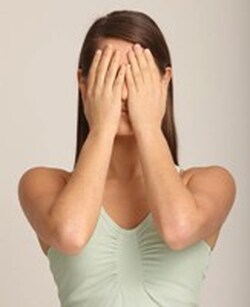
Palming is a technique to relax your eyes when they are tired. How often are you told, " all you have to do is relax " ? Well, how do you relax ? You can relax your eyes with palming by holding your hands before closed eyes while you rest and breathe slowly. Once you have experienced the relaxation, slowly open your eyes and take away your hands and attempt to keep the same restfulness with your eyes open.
Seat yourself comfortably in a chair so you can lean forward and rest your elbows on your knees - or preferably a desk or table top. Open your hands with the fingers touching and hold your palms toward you. Gently close your eyes and place your palms against your face over your eyes to block light. Do not touch your eye lids with your palms. Simply cover your eyes. Breathe slowly and count your breaths. Diaphragm breathing is preferable. Notice the relaxing feeling you are experiencing, especially in the area of your eye lids. After counting at least eight breaths, slowly lower your hands, open your eyes and raise your head. Continue to experience the relaxed feeling in your eyes even though palming is finished.
Seat yourself comfortably in a chair so you can lean forward and rest your elbows on your knees - or preferably a desk or table top. Open your hands with the fingers touching and hold your palms toward you. Gently close your eyes and place your palms against your face over your eyes to block light. Do not touch your eye lids with your palms. Simply cover your eyes. Breathe slowly and count your breaths. Diaphragm breathing is preferable. Notice the relaxing feeling you are experiencing, especially in the area of your eye lids. After counting at least eight breaths, slowly lower your hands, open your eyes and raise your head. Continue to experience the relaxed feeling in your eyes even though palming is finished.
AWARENESS OF THREE SENSES
|
1. Side Vision 2. Hearing 3. Touch
While doing almost anything you will be more efficient if you are aware of other senses while you are looking at something. In other words, you do not want to shut down or off while concentrating. Unfortunately many teach you to shut off when concentrating. As you master using the other senses you will be more relaxed.
Side vision is the first. Simply notice things off to the side, not only straight ahead. Only be aware of them. Do not try to name the objects or give them any meaning.
|
Second is hearing. While you are concentrating, are you aware of background noises around you?
The third is feeling, or touch. This is the sensation of your feet against the floor or the feeling of your body pressing against a chair while seated.
Eventually apply the awareness of three senses to everyday events such as reading, sitting, watching TV, driving, playing sports, thinking,
Taming My Bifocal- your bifocal is not your enemy!
This is for those who have a bifocal as part of their lens therapy. It is also helpful for anyone who has a bifocal.
Choose Your Poison
You need to choose your poison. You fight a line in a bifocal or distortion in a progressive. We recommend the bifocal.
People commonly believe it is difficult to adapt to a bifocal, and it is true for some. Yet, why is it difficult? Usually another vision condition is the culprit. Two main conditions make adaption difficult. One is an eye turn and the other is eyestrain. So much energy is used for these conditions that there is little energy left to adapt to that line in your vision.
This is for those who have a bifocal as part of their lens therapy. It is also helpful for anyone who has a bifocal.
Choose Your Poison
You need to choose your poison. You fight a line in a bifocal or distortion in a progressive. We recommend the bifocal.
People commonly believe it is difficult to adapt to a bifocal, and it is true for some. Yet, why is it difficult? Usually another vision condition is the culprit. Two main conditions make adaption difficult. One is an eye turn and the other is eyestrain. So much energy is used for these conditions that there is little energy left to adapt to that line in your vision.
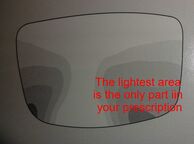
Why a Bifocal, not a Progressive?
The progressive lens is marketed mainly for cosmetics. No one can see your bifocal line. It’s a molded lens that starts with your distance vision prescription in the upper10% of your glasses. Through varying curvatures it ends at your near prescription in the lower 10% of your glasses. As you move your eyes down this narrow channel, the power progressively gets stronger-hence its name. Everywhere else is distorted. It is especially narrow for your middle distance like computer screens and, price tags. It is so narrow we make a special measurement to see if one eye is closer to your nose. If missed, one eye would see in the channel while the other would look through distortion.
Most progressives have a clear reading area of only 5 inches. Many people struggle to find the sweet spot for each point from distance to a reading distance. The enclosed picture of a progressive shows the areas of distortion. The darkened areas to the side are someone’s else’s prescription as the lens progresses from your distance to near vision.
Why is the area outside the channel someone else’s prescription?
A prescriptive lens has a curvature. The steeper the curve, the stronger the prescription. The curvature of the lens gets steeper from the top to the bottom of the lens. Since the progressive is molded, like a jell-O mold, the section of the lens outside the channel must also be curved. Those curves do not match your prescription. If you’ve ever put on someone else’s glasses, you can see the distortion from that. A bifocal does not do that. It is fused. The lens starts with your distance prescription. A section is carved out on the bottom and another lens with your near vision prescription is placed in the carved out section. Thus, every portion of the bifocal lens is your prescription.
Usually 50 to 60% of the top of your bifocal is entirely your distance prescription. The whole width of the bifocal segment is your near vision prescription. You have clear vision across the entire page rather than the five inches limited with a progressive. You immediately see clearly no matter where you look, even the sides. You don’t have to move your head when reading, required by a progressive. Accordingly, you do not slow reading down and interfere with vision processing which the progressive does.
A Bifocal Mimics Natural Vision
Our eyes change focus immediately when we look from distance to reading up close. They do not progressively change like a slide projector zooming in and out. It is immediate. You want immediate clarity, and hunting for a sweet spot in the progressive slows vision function down.
Yes, there is a line to contend. Yet, people who do not have an eye turn or eyestrain mentioned earlier, normally adapt within a few minutes if not within three days. Some adapt immediately.
Why does a progressive interfere with vision processing and reading speed?
Because of the very narrow channel, you have to move your head to read. When you move your head vision processing skills shut down and auditory processing opens up. Thus your reading speed drops to a maximum of 250 words per minute-about as fast as you can talk. Imagine what giving a progressive to a student does to the student’s academics.
Special Bifocals
Desktop computer screens present a problem whether you have a bifocal and especially a progressive. You have to tip your head back to view the screen through the near vision section. We have special computer bifocals where the top is set for that slightly further distance of the computer screen and the reading segment is for regular close work. Progressives attempt to do the same but still have a narrow view for both the computer screen and reading.
Some occupations like carpenters, auto mechanics, and electricians require bifocals positioned in unique positions. If you have any of those jobs ask us how we can make your work more comfortable.
How do I adapt to my Bifocal?
3 steps
1. Lower your chin if the reading segment gets in your way at distance. If the car in your rearview mirror looks fuzzy, simply lower your chin and lift your eyes to avoid the reading segment.
2. Rather than raise your chin, hold reading material near your waist when the distance section is in your way. You could raise your chin, but who wants to drown in the rain? As an example, always fold your newspaper and hold it in your lap or on the table so you can glance easily through the reading segment without raising your chin. If you held the paper at its full length with arms extended you have to raise your chin to see through the reading segment.
3. Look over the top of the bifocal line when on stairs or stepping off curbs. If you look through the reading segment, not only will the stairs appear blurry, they will appear to be at a different distance. You would then probably miss your step and even trip.
Note: The golf thing! Some golfers fear the line will get in the way of their swing and request golf glasses with the reading segment placed lower. We now may have found a golfing problem. One of the biggest problems in hitting a golf ball is raising your head as you swing. With the bifocal you have to keep your head down.
How do I adapt to My Progressive?
There are no special steps like we described above for a bifocal. In addition to moving your head up and down and sideways, you have to learn to tolerate distortions and small areas of clear vision.
Yes, many patients desire the progressives and we provide them. Not only do we provide them, we make sure they are measured correctly for you to give you minimal discomfort. Don’t worry if you find the progressive intolerable, we will supply a bifocal if you return your progressive within two months.
WARNING:
Whether you have a bifocal or a progressive be careful during the first few days of adaption (up to two weeks for a progressive). You could miss your step on stairs or miss pour coffee on the table rather than the cup, etc.
The progressive lens is marketed mainly for cosmetics. No one can see your bifocal line. It’s a molded lens that starts with your distance vision prescription in the upper10% of your glasses. Through varying curvatures it ends at your near prescription in the lower 10% of your glasses. As you move your eyes down this narrow channel, the power progressively gets stronger-hence its name. Everywhere else is distorted. It is especially narrow for your middle distance like computer screens and, price tags. It is so narrow we make a special measurement to see if one eye is closer to your nose. If missed, one eye would see in the channel while the other would look through distortion.
Most progressives have a clear reading area of only 5 inches. Many people struggle to find the sweet spot for each point from distance to a reading distance. The enclosed picture of a progressive shows the areas of distortion. The darkened areas to the side are someone’s else’s prescription as the lens progresses from your distance to near vision.
Why is the area outside the channel someone else’s prescription?
A prescriptive lens has a curvature. The steeper the curve, the stronger the prescription. The curvature of the lens gets steeper from the top to the bottom of the lens. Since the progressive is molded, like a jell-O mold, the section of the lens outside the channel must also be curved. Those curves do not match your prescription. If you’ve ever put on someone else’s glasses, you can see the distortion from that. A bifocal does not do that. It is fused. The lens starts with your distance prescription. A section is carved out on the bottom and another lens with your near vision prescription is placed in the carved out section. Thus, every portion of the bifocal lens is your prescription.
Usually 50 to 60% of the top of your bifocal is entirely your distance prescription. The whole width of the bifocal segment is your near vision prescription. You have clear vision across the entire page rather than the five inches limited with a progressive. You immediately see clearly no matter where you look, even the sides. You don’t have to move your head when reading, required by a progressive. Accordingly, you do not slow reading down and interfere with vision processing which the progressive does.
A Bifocal Mimics Natural Vision
Our eyes change focus immediately when we look from distance to reading up close. They do not progressively change like a slide projector zooming in and out. It is immediate. You want immediate clarity, and hunting for a sweet spot in the progressive slows vision function down.
Yes, there is a line to contend. Yet, people who do not have an eye turn or eyestrain mentioned earlier, normally adapt within a few minutes if not within three days. Some adapt immediately.
Why does a progressive interfere with vision processing and reading speed?
Because of the very narrow channel, you have to move your head to read. When you move your head vision processing skills shut down and auditory processing opens up. Thus your reading speed drops to a maximum of 250 words per minute-about as fast as you can talk. Imagine what giving a progressive to a student does to the student’s academics.
Special Bifocals
Desktop computer screens present a problem whether you have a bifocal and especially a progressive. You have to tip your head back to view the screen through the near vision section. We have special computer bifocals where the top is set for that slightly further distance of the computer screen and the reading segment is for regular close work. Progressives attempt to do the same but still have a narrow view for both the computer screen and reading.
Some occupations like carpenters, auto mechanics, and electricians require bifocals positioned in unique positions. If you have any of those jobs ask us how we can make your work more comfortable.
How do I adapt to my Bifocal?
3 steps
1. Lower your chin if the reading segment gets in your way at distance. If the car in your rearview mirror looks fuzzy, simply lower your chin and lift your eyes to avoid the reading segment.
2. Rather than raise your chin, hold reading material near your waist when the distance section is in your way. You could raise your chin, but who wants to drown in the rain? As an example, always fold your newspaper and hold it in your lap or on the table so you can glance easily through the reading segment without raising your chin. If you held the paper at its full length with arms extended you have to raise your chin to see through the reading segment.
3. Look over the top of the bifocal line when on stairs or stepping off curbs. If you look through the reading segment, not only will the stairs appear blurry, they will appear to be at a different distance. You would then probably miss your step and even trip.
Note: The golf thing! Some golfers fear the line will get in the way of their swing and request golf glasses with the reading segment placed lower. We now may have found a golfing problem. One of the biggest problems in hitting a golf ball is raising your head as you swing. With the bifocal you have to keep your head down.
How do I adapt to My Progressive?
There are no special steps like we described above for a bifocal. In addition to moving your head up and down and sideways, you have to learn to tolerate distortions and small areas of clear vision.
Yes, many patients desire the progressives and we provide them. Not only do we provide them, we make sure they are measured correctly for you to give you minimal discomfort. Don’t worry if you find the progressive intolerable, we will supply a bifocal if you return your progressive within two months.
WARNING:
Whether you have a bifocal or a progressive be careful during the first few days of adaption (up to two weeks for a progressive). You could miss your step on stairs or miss pour coffee on the table rather than the cup, etc.
A Lens Therapy success story
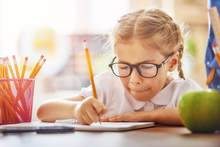
Recently a bubbly Lillian came by the office excited with her changes from lens therapy. Once Lillian put on her glasses she found reading easy with which she previously struggled and hated. She read all the way home in the car. She now loves reading, and her tutor said she made a 300% improvement since lens therapy. Mom was equally excited
Lens therapy, provided mostly by developmental optometrists, is the use of prescriptive lenses for close work like reading or viewing a computer screen. The lenses do not compensate for eye defects but reduce the stress of close work to enhance visually efficiency.
Lillian was found to have eyestrain requiring lens therapy and we were considering even more extensive vision therapy to help her visually related learning problem. We elected to first see the results of lens therapy. At times doing the simplest thing first is enough. In Lillian’s case it was.
Lens therapy, provided mostly by developmental optometrists, is the use of prescriptive lenses for close work like reading or viewing a computer screen. The lenses do not compensate for eye defects but reduce the stress of close work to enhance visually efficiency.
Lillian was found to have eyestrain requiring lens therapy and we were considering even more extensive vision therapy to help her visually related learning problem. We elected to first see the results of lens therapy. At times doing the simplest thing first is enough. In Lillian’s case it was.

